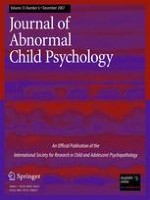01-12-2007
ADHD Correlates, Comorbidity, and Impairment in Community and Treated Samples of Children and Adolescents
Gepubliceerd in: Research on Child and Adolescent Psychopathology | Uitgave 6/2007
Log in om toegang te krijgenAbstract
Patterns of correlates, comorbidity and impairment associated with attention-deficit hyperactivity disorder (ADHD) in children and youth were examined in representative samples from the community and from treatment facilities serving medically indigent youth in Puerto Rico. Information from caretakers and youths was obtained using the Diagnostic Interview Schedule for Children, (version IV), measures of global impairment, and a battery of potential correlates. In the community (N = 1,896) and the treated samples (N = 763), 7.5 and 26.2% of the children, respectively, met criteria for DSM-IV ADHD in the previous year. Although the prevalence rates and degree of impairment differed, the general patterns of correlates, comorbidity and impairment were similar in both populations. The exceptions were associated with conduct disorder, anxiety, impairment in the ADHD comorbid group, and age factors that appeared to be related to selection into treatment.
